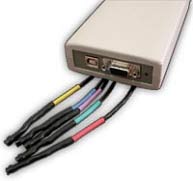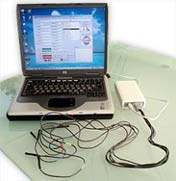 |
  
Analyzer is Blood Tester allowing do blood test automatically, without
penetration, upon measuring data of temperature of human body's' biologically
active, so-called reference points. The device is able to analyze
the given results by help of specialized software developed upon experience
of many years. This software named USPEH (software for "skrinning"
evaluation of hemodynamic, biochemical, immuno biological parameters
of vitality of healthy and ill humans). Analyzer makes possible to
transfer the measured parameters to PC, and evaluation of that parameters
with printing of the protocol.
Biologically active points used during analysis:
· bifurcation of the left and
. right neck artery (two points);
· left and right armpit (two points); · umbilici (one point).
Main features and advantages of the Analyzer:
· simplicity of method of Analyzer using, ease of operation and attainment
· compact size
· spread sort of parameters to be analized
· short time of getting the information
· capacity to handle four patient
· reliability and authentity of measured results
· finding out and prevention of such an illnesses at their early stage, as heart attack, cerebral accident, diabetes, cancer etc.
Facts proved by clinic examination results:
· Examination results of analyzer differ not more than 5.10% from clinic examination results.
· nalyzer makes possible clinic blood test of patient in 180-.720 seconds without cupping and makes evaluation of results by USPEH software.
AMP software makes possible:
· 1. Finding out the state of organism, in connection with its hemodinamic balance, water and gas exchange from position of homeostasis,
which is connected with fermentation and immunologic correction; to state metabolism of nerves, heart, blood circulation, insides, support and moving organs and other pathologies.
· 2. Regarding to central nerve system, the device makes possible to state brain blood saturation (enough-not enough); state of brain artery (spasm, dilatation);state of brain venulas
(spasm, dilatation) distraction of brain blood emission and its prognostisation; state of brain third vault (dimensions);
dimensions of cerebroventricular data; pressure of spinal marrow; conductivity of nerves and muscles upon content of K, Na, Ca, Mg in blood, aptitude to spasms or weakness of muscles.
· 3. In regard of heart and blood circulation system the device makes possible to state diagnosis of coronacardiosclerosis; malfunction of myocard blood supply; shrinking of the emitted
blood quantity; increasing of the emitted blood quantity; arrhythmia, temporary data of heart cycle; type of heart circulating: hyper kinetic, normal kinetic, hypo kinetic.
· 4. In regard of lungs the device shows vital volume of the lungs; remaining volume of the lungs; blood circulation of the lungs; flexibility of the lungs which allows state
diagnosis of basic diseases as pneumonia, chronic tracheobronchitis with asthmatic component, chronic pneumonia.
· 5. In regard of liver device makes possible to state blood circulation of liver; activity of enzymes AST, ALT; to state diagnosis of liver inflammation, liver cirrhosis.
· 6. In regard of kidney device makes possible to state activation of enzymes glycinamidinotransferase and glutomatedegidrogenase; lactatedehydroginase and acidic phosphates,
which allows to find out malfunction of filtering, resoption, chronic nephrites, glomerulonephrytes, pielonephrytes.
· 7. Upon exchange of water, the device allows to state electrolytic water malfunctions types the predecessor of osteochondrosis; forms of dyshdria; hypohydrattation of cellules;
hyperhdratation inside of cellules.
· 8. Upon finding out of state of enzymes, consumption of oxygen per 100 g of tissues, malono dyaldehyde data, dyenic conjugates, lactic acid and pyrine acid, functional hemodynamic
and energetic balance evaluation, water electrolytic and gas homeostasys tating, device makes possible:
8.1. To evaluate compensational ability of the organism.
8.2. To select the most applicable physiotherapy, methods of informational treatment, proper KVS, BOSS, LASER therapy, acupuncture or other methods, taking into consideration
their ethnology and pathogenesis.
· 9. Archivates changes in organism and inside by means of service programs during examinations and treatments; Device is able to make full blood test and 117 further vital function test in
180 . 720 seconds, without cupping, and creates preliminary diagnosis with printing to doctor.
After examination, Analyzer offers possible choise to doctor from the following list,
EXAMPLE:Post hypoxic encephalopathia. Delirium's spasmic syndrome. Malfunction of lunges and heart. Liver encephalopathia. Bilirubin (general) 61,73mmol/l Proposed examination of sugar level.
To exclude kidneys chronical mutation (chronical nephritis, chronical nephritis glomerulosa). Spine osteochondrosys. Malfunction of water and electrolytic exchange malfunction. Plasma Ca change
( Ca bone texture). Vegetative, blood vascular system dystonia, liquor-vena dyscirkulacio. Liquorhypertensin syndrome. Hypoxic encephalopathia. Liquor-vena dyscirkulacio. Liquor hypertenesiae
syndrome. (Acute hepato-pancreatitis? Malfunction of lungs and heart? To disclose interstitial pneumonia? Low sugar hypertenesia. Tonic noise possible. Mg=0,532 Ca=2,5. Width of brain third
camber =7,5 cm. To disclose mutation of prostate. Blood flow of other organs = -2,1%. To disclose change of the homeostasis pulmonalis mechanism (restrictive mutation of lungs function).
Tiffno index decreases (normal for men at range of 84..110%) upto 35,0 % etc....
Measurement results:
Blood formula:
1. Haemoglobin : g/l
2. Erythrocytes : 1/mm3
3. Lymphocyte concentration : %
4. Quantity of leucocytes :
5. Segmented neutrofiles : %
6. Rate of erythrocytes precipitation: mm/h
7. Eosinophile concentration : %
8. Monocytes concentration : %
9. Stab neutrofiles : % Electrolyte metabolism:
10. The concentration of Ca plasma (norm: 2,02..2,2) : mmol/l
11. The concentration of Mg plasma (norm: 0,85..0,95) : mmol/l
12. The concentration of K plasma (norm: 4,14..4,56) : mmol/l
13. The concentration of Na plasma (norm: 137..147) : mmol/l
The system of blood fibrilation:
14. The begining of fibrillation min. sec.
15. The end of fibrillation : min. sec.
16. The thrombocytes : - thousands
17. The haematocrite (norm: 39..45) : % The enzyme
system:
18. AST (norm 0,1..0,45) : mmol/l
19. ALT (norm 0,1..0,68) : mmol/l
20. AST (norm 8..40) : ?/l
21. ALT (norm 5..30) : ?/l
22. ALT/AST :
23. The amylase (norm: 12..32) : g/l/h
24. The bilirubin (norm: 8,35...20,52) : mkmol/l
25. The conjugated bilirubin (norm: 2,2..6,1) : mkmol/l
26. The unconjugated bilirubin : mkmol/l
27. The concentration of plasma albumen (g/l) : g/l The
oxygen asimilation and transportation:
28. The plasma density (norm: 1048..1055):
29. The volume of circulatory blood(norm: 68..70 man) (norm: 65..69women)
ml/kg
30. The minute volume of circulatory blood: ml/min
31. The rate of O2 delivery to tissue (norm 260..280 ml/sec):
32. The surface of gaseous exchange: sq.m.
33. The vital capacity of lungs: ml.
34. The transportation of oxygen (norm: 900..1200 ml/min.): ml.
35. The quantity of assimilated oxygen on 100 gr. of tissue(norm: 3.12)
:
36. The content of O2 in arterial blood (norm: 95%..98%): %
37. The cardiac ejection (norm: 60..80 ml.) : ml
38. The quantity of assimilated oxygen on kg : ml/min/kg
39. The pulmonary ventilation (norm: 4..10 ml/min): l/min
40. The quantity of assimilated oxygen ml/min (norm: 200..250): ml/min
41. The quantity of myocardial oxygen consumption (norm: 7..10 ml/min):
ml/min
42. The deficit of circulatory blood:
43. The vital capacity of lungs in an expiration phase:
44. The maximum flow of air (norm: men 74..116 l/min):
45. Test Tiffno (norm: men. 84..110, women 86..109 %):
46. The fibrinogen (norm: 2,0..3,5):
47. The concentration of creatinine (norm: 55..90): mkmol/l
48. The dopamine hydroxylase (norm: 31,5..32,5 nanom/ml/min): nanom/ml/min
49. The concentration of lactic acid (norm: 0.99..1,38 mmol/l): mmol/l
50. The concentration of urea (norm: 2,5..8,3) : mmol/l
51. The concentration of glucose (norm: 4..6): mmol/l
52. The concentration of triglyceride (norm: 0,55..1,85): mmol/l
53. The cholesterol (norm: 3,6..7,02[Fredrickson et al., 1967]): mmol/l
54. B-lipoprotein (mmole/litre): mmol/l
55. B-lipoprotein (norm: 3..6): g/l
56. Low-density lipoproteins (norm: 2,35..2,43 mmol/l): mmol/l
57. Lowest-density lipoproteins (norm: 0,20..0,22 mmol/l): mmol/l
58. High-density lipoproteins (norm: 1,41..1,45 mmol/l): mmol/l
The CO2 asimilation and transportation:
59. CO2 discharge (norm: 119..182,4 ml/min): ml/min
60. The content of CO2 gas in arterial blood (norm: 51..53): %
61. The content of CO2 gas in venous blood (norm: 39..45): mm of mercury
62. The rate of ??2 production (norm: 150..340) : ml/min The
internal blood flow, in % to total blood flow:
63. The myocardium current of blood in (norm: 4.67%): % of total blood
flow
64. The muscles current of blood in(norm: 15.75%) : % of total blood
flow
65. The cerebral current of blood in(norm: 13.86%) : %of total blood
flow
66. The hepatic-portal current of blood in(norm: 27.78%) : % of total
blood flow
67. The nephritic current of blood in(norm: 23.34%): % of total blood
flow
68. The skin current of blood in(norm: 8.55%): % of total blood flow
69. The other organs current of blood in(norm: 6.23%) : % of total blood
flow The internal blood flow, in ml/min:
70. The myocardium current of blood(norm: 250..290 ml/min): ml/min
71. The muscles current of blood (norm: 930..990 ml/min): ml/min
72. The cerebral current of blood (norm: 750..800 ml/min): ml/min
73. The hepatic-portal current of blood (norm: 1690..1740 ml/min): ml/min
74. The nephritic current of blood (norm: 1430..1490 ml/min): ml/min
75. The skin current of blood (norm: 500..535 ml/min): ml/min
76. The other organs" current of blood (norm: 375..390 ml/min): ml/min
77. The acetylcholine (norm: 81,1..92,1): mkg/ml
78. The acetylcholineaesterase of erythrocytes : mkmol/l The
time slice of cardiomechanics:
79. The interval PQ : sec
80. The interval QT : sec
81. The interval QRS : sec
82. The contraction of miocard of the left ventricle of heart (norm:
60..85%): %
83. The arterial pressure of systolic: mm of mercury
84. The arterial pressure of diastolic: mm of mercury
85. The resistance of lesser circulation (norm: 140..150):din/cm*sec
86. The width of the third ventricle of cerebrum (norm 4..6 mm): mm
87. The pressure of spinal liquid (norm: 90..140 millimeter of water):
millimeter of water
88. The central venous pressure (norm: 70..150 millimeter of water):millimeter
of water
89. The time of lesser circulation(norm: 16,0..23,0) : sec
90. The time of systemic circulation(norm: 4,0..5,5): sec
91. The spectral wave-length absorption of ??2 in blood(norm: 4,165..4,335):
mkm
92. The spectral wave-length absorption of N2O in blood(norm: 3,7828..39372):
mkm
93. The concentration of H2 of gastric juices(norm: 1,2..1,7):
94. PH blood (norm: 7,36..7,45) :
95. SH (norm: 7,32..7,40) :
96. The cardiac work (Joule) (norm: 0,692..0,788):
97. The glutaminic acid (norm: 0,0045..0,0055): mmol/l
98. The tyrosine acid (norm:1,4...1,5 mg*%[Zbarskiy B.I., 1972]):
99. The creatine kinase of muscules (norm: 473..483mkmol/min/kg):
100. The creatine kinase of cardiac (norm: 35,1..38,1..mkmol/min/kg):
101. The glycogen (norm: adult 11,7...20,6; child 7,5...11,7 mg): %
102. The wasting power of life support(norm: 1,23..4,3 kcal/kg/min):kcal/kg/min
103. The working rate of assimilated oxygen (norm: 45..50): %
104. The time of single load (norm: 3..10): min.
105. The respiratory factor (norm: 0,8..0,9):
106. The Tyrozine: mmol/l
107. The cerebral blood flow on 100g of tissue (norm: 50..55ml/100g):
108. The testosterone of urine (norm: men:6,93..17,34 women:2,77..10,4
mkmol/24hours):
109. Total estrogen (norm: men:17,95..64,62 women:78,98..376,95 nanomol/24hours):
110. Extracellular water (norm: 21-23): %
111. Cellular water (norm: 39-42): %
112. Total water (norm: 53-60): %
113. The blood flow per 1gr of thyroid gland (norm: 4ml):
114. The blood flow per 1gr of cerebral tissue (norm: 2,9..3,2 ml):
115. The index of extraction of tissue oxygen (norm: child 0,296..0,36;adult
0,26..0,34):
| |